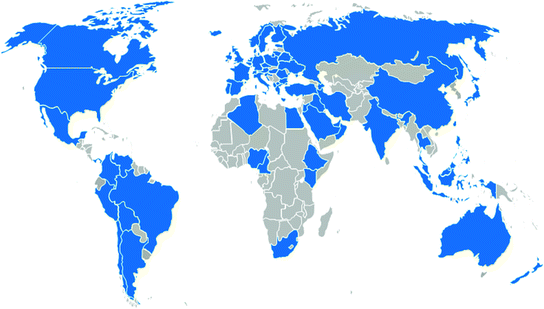Fig. 2.1
Consensus conference process
2.1 Step 1. Evidence Collection and Analysis
The aim of this conference was to identify all the interventions influencing mortality in the perioperative period, including only evidence derived from RCTs and meta-analyses of RCTs.
For this purpose, two different search strategies were proposed: one to identify all the randomized trials based on the largely validated research strategy proposed by Robinson et al. [4] and the other a wider search strategy for meta-analyses identification (Table 2.1). To increase the sensitivity of this phase of research, additional strategies were adopted. Experts in the perioperative area were contacted to obtain suggestions on further trials, along with more than 100 international anesthesiological and surgical societies and more than 50 patients and nurses associations. Moreover, the authors contacted all editorial offices of peer-reviewed journals with impact factors relative to perioperative medicine, including surgery, anesthesiology, critical care medicine, and cardiac or cardiovascular systems. Proposal of new articles was encouraged and allowed until the consensus meeting held in Milan.
Table 2.1
PubMed search strategy for randomized controlled trials and meta-analysis of randomized controlled trials, and number of articles identified by the query when it was concluded
Search strategy for meta-analyses of RCTs | Search strategy for RCTs |
|---|---|
Systematic[sb.] AND (surgery[tiab] OR surgic*[tiab] OR operation*[tiab]) AND ((myocardial AND infarction) OR (death* OR survival OR mortality OR prognosis)) AND (prevent* OR reducti* OR reduci*) | (Surgery[tiab] OR surgic*[tiab] OR operation*[tiab]) AND ((death* OR survival OR mortality)) AND (prevent* OR reducti* OR reduci*) AND (significat* OR significan*) AND (randomized controlled trial[pt] OR controlled clinical trial[pt] OR randomized controlled trials[mh] OR random allocation[mh] OR double-blind method[mh] OR singleblind method[mh] OR clinical trial[pt] OR clinical trials[mh] OR (clinical trial[tw] OR ((singl*[tw] OR doubl*[tw] OR trebl*[tw] OR tripl*[tw]) AND (mask*[tw] OR blind[tw])) OR (Latin square[tw]) OR placebos[mh] OR placebo*[tw] OR random*[tw] OR research design[mh:noexp] OR comparative study[tw] OR follow-up studies[mh] OR prospective studies[mh] OR crossover studies[mh] OR control*[tw] OR prospective*[tw] OR volunteer*[tw]) NOT (animal[mh] NOT human[mh]) NOT (comment[pt] OR editorial[pt] OR meta-analysis[pt] OR practice-guideline[pt] OR review[pt])) |
3,437 articles identified | 4,991 articles identified |
All studies identified were reviewed at an abstract/title level by a trained team of physicians, to identify all the papers with all the following characteristics:
based on randomized evidence,
focused on nonsurgical interventions (drugs, strategy, or techniques),
reporting on mortality, with a statistically significant difference between cases and controls,
published in a peer-reviewed journal,
including adult patients undergoing surgery in any setting.
Only articles fulfilling all these criteria were included in the next step of the consensus process.
2.2 Step 2. Web-Based Polling and First Consensus Building
Two separate sessions of Web-based polling were proposed, allowing 1,090 participants from 77 countries to participate (Fig. 2.2). Participants covered a large area of medical specialties. The upcoming consensus was advertised via Web, e-mail and by information spreading through scientific networks.


Fig. 2.2
The 77 countries that participated to the consensus conference
From June 1 to June 8, 2011, participants voted through a Web-poll on the beneficial or detrimental effect on mortality of the interventions proposed in the previous phase. For each intervention, participants were asked to express their agreement, choosing from a nominal scale, and were actively encouraged to express their opinion on a separate open panel. All opinions were collected and reported to the consensus meeting.
Web participants were required to disclose any potential conflict of interest for each proposed intervention, and they were invited to suggest new articles until the date of the consensus meeting.
2.3 Step 3. Consensus Meeting
A meeting was held on June 8, 2011, at the Vita-Salute University of Milan among a task force composed by anesthesiologists, intensivists, surgeons, cardiologists, and epidemiologists. During the meeting, new participant-proposed articles were discussed for inclusion. Every new or former article was double-checked for adherence to inclusion criteria.
Each consensus topic was presented by a reporter and a co-reporter. This was followed by a discussion through consensus building. A simple vote was taken if at least one participant was against the inclusion of the paper in the major topics at the end of the discussion, and a position statement was approved describing the reasons for the inclusion of this topic and its effect on mortality. Final topics [5–18] are reported in Table 2.2, while major excluded topics are reported in Table 2.3. Reasons for exclusion were the following:
Table 2.2
The consensus drugs/techniques influencing perioperative survival
Topic | Setting |
|---|---|
Reduce perioperative mortality | – |
Chlorhexidine oral rinse | Cardiac surgery |
Clonidine | Noncardiac surgery |
Insulin for glycemic control | Cardiac surgery |
Intra-aortic balloon pump | Cardiac surgery |
Leukocyte depletion | Cardiac surgery |
Levosimendan | Cardiac surgery |
Neuraxial anesthesia
Stay updated, free articles. Join our Telegram channel
Full access? Get Clinical Tree
 Get Clinical Tree app for offline access
Get Clinical Tree app for offline access

|

